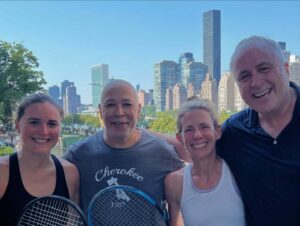 I was stuck in traffic recently and struck up a conversation with the Uber driver. He was a young man from Pakistan who has lived in the U.S. for 11 years. Married and about to become a father, he and his wife share a communal home with his brothers and their families. During our chat, he asked me if I ever feel lonely not living with my family. My first instinct was to respond with a witty remark about the challenges living with my family would present. But I paused for a minute during which he said, “Don’t you get lonely? Where do Americans go when they’re lonely?”
I was stuck in traffic recently and struck up a conversation with the Uber driver. He was a young man from Pakistan who has lived in the U.S. for 11 years. Married and about to become a father, he and his wife share a communal home with his brothers and their families. During our chat, he asked me if I ever feel lonely not living with my family. My first instinct was to respond with a witty remark about the challenges living with my family would present. But I paused for a minute during which he said, “Don’t you get lonely? Where do Americans go when they’re lonely?”
In March 2020, the White House launched the “15 Days to Slow the Spread” initiative to combat COVID-19. Days later, travel bans were implemented, schools closed, churches shuttered, offices emptied, and most people began working from home. While the lockdown had a significant impact on many areas of our lives, for many, the feelings of loneliness and isolation were the most serious consequences. We live in a challenging world right now. People are angry, disheartened, many even feeling disenfranchised.
According to the National Institute on Aging (NIA), “Social isolation is the lack of social contacts and having few people to interact with regularly.” It defines loneliness as “the distressing feeling of being alone or separated.” These issues, while not new, became undeniable during the lockdown—an uncomfortable truth that many of us are still grappling with.
Back in my Uber, I didn’t have an answer to my driver’s question. Later, I looked into it, assuming church might be the most popular destination for those seeking connection. However, data suggests otherwise. Jeffrey M. Jones from Gallup.com reports that regular religious service attendance has steadily declined over the years—from 42% of U.S. adults two decades ago to just 30% today. Meanwhile, a study in USA Today shows that remote work is here to stay, likely growing. And who among us isn’t guilty of connecting with the world primarily through a screen?
Growing up in New York City, I never gave much thought to connection. I’ve lived my entire life among millions of people rushing from one place to another. But one day, while at work at Roosevelt Island Racquet Club, I realized the foundation of connection is all around me. I joined the club because I loved tennis, but I’ve stayed because I love the community. In my early days, I thought the club would make a great sitcom or reality show, thanks to its memorable characters and compelling ensemble. Someday I might still pursue that idea, but for now, I’m just enjoying being part of this thriving, vibrant community.
You can play tennis anywhere, and it’s not hard to find someone at your level. But our club offers something unique. A relatively new member who came from a large, prestigious tennis club told me, “I could have been an active member there for a year without ever knowing anyone.” That doesn’t happen here. Roosevelt Island Racquet Club is a smaller, player-focused club—a collective of players at all levels, members, non-members, coaches, juniors, seniors, and families—all brought together by a shared passion for tennis.
There’s a lot more going on than 12 Har-Tru courts, lounges, locker rooms, and gym. We get to know our members. When pairing up players, it’s not just the levels that matter. Compatibility is more than just a number. We try to find people who might have similar preferences or interests, be it on or off the court. People who might want to play again and again.
Our strategy seems to work. There are members who have formed small unofficial groups of their own. They talk, laugh and continue their connection outside the club; actively, looking for others to welcome into the fold. While tennis may be the conduit, the result is a healthy, thriving community right here in New York City. Friendships are formed, connections are made.
We all know that tennis is good for the heart. But if my experience at The Roosevelt Island Racquet Club is any indication, it’s also good for the soul. Right there, right in front of me, was the answer to the question my new friend from Pakistan was asking. I watch a community grow and thrive every single day. Strangers, even rivals on the court, become friends, sometimes for a lifetime. They break bread together. Dance. Party. Have fun. They show up to support one another on a regular basis. They watch their kids grow together, develop a sense of self, a healthy self-esteem and a love for all that tennis has to offer. They do what people in a community do. They connect.
As the cheesy ‘60s pop song goes, “When you’re alone and life is making you lonely,” don’t go downtown. Instead, grab your racquet and head to the court. Make that home court.
–by Teddy Angelus

